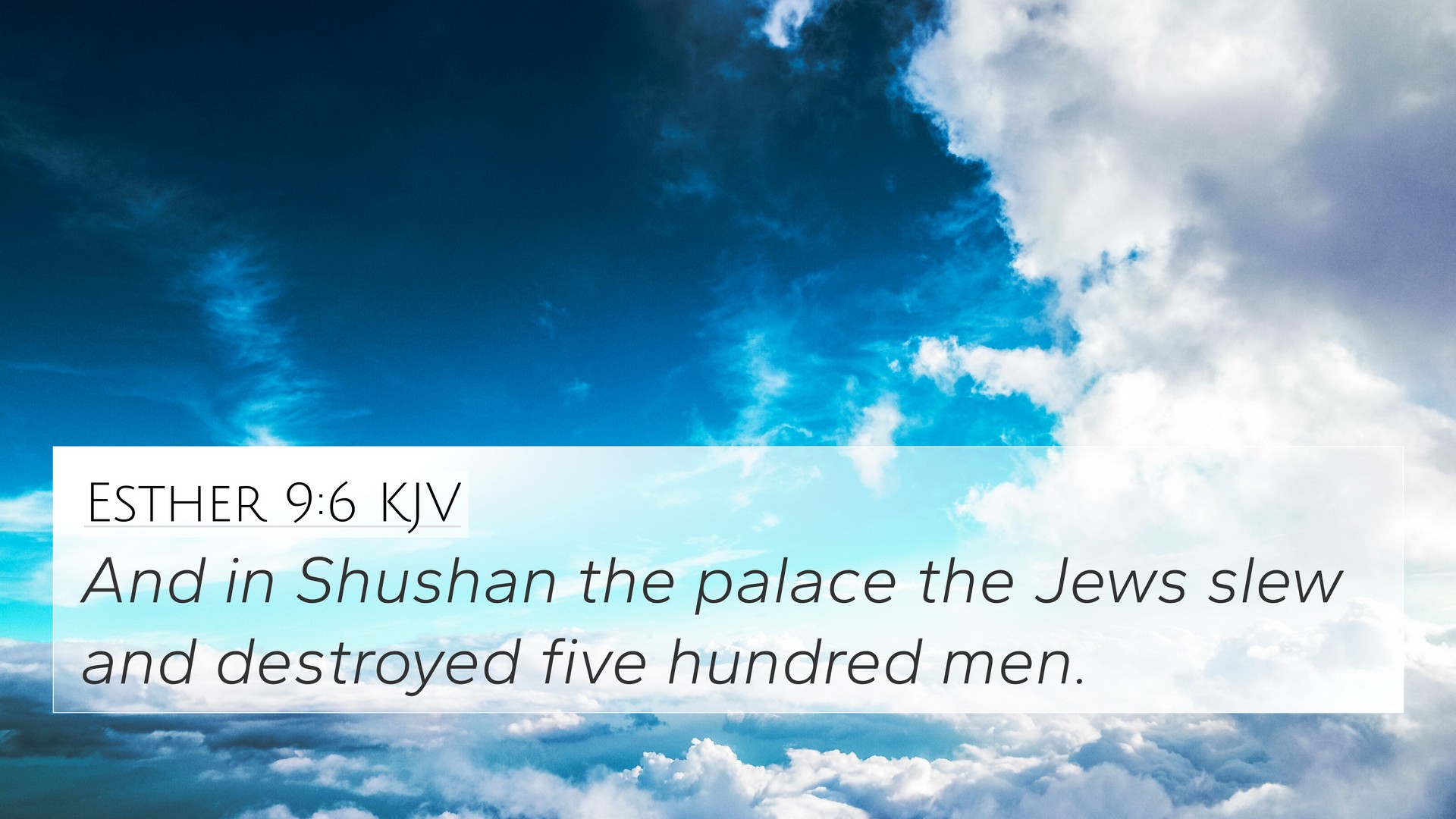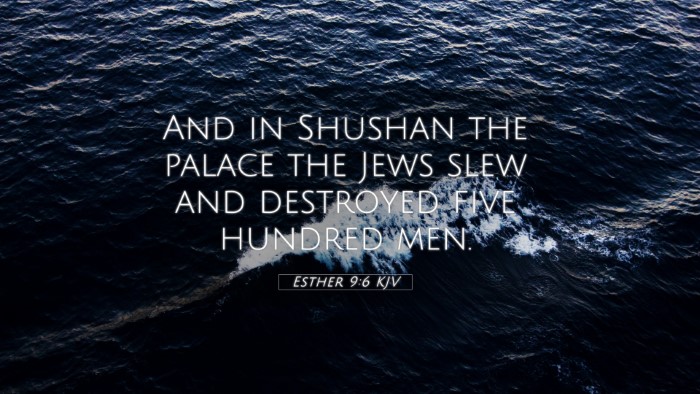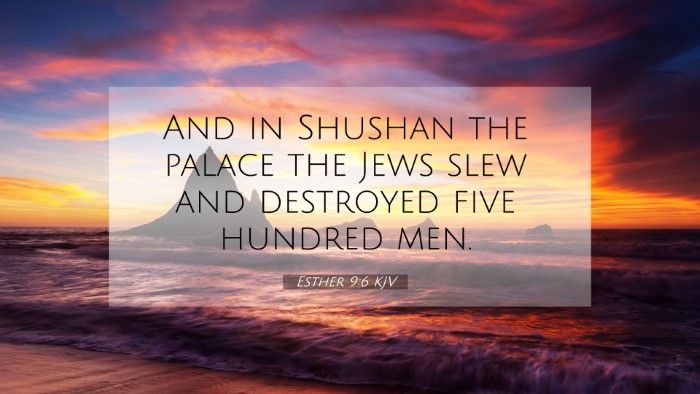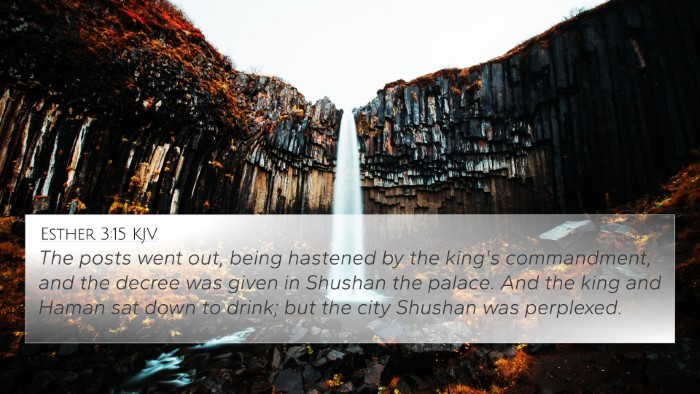Understanding Esther 9:6
Esther 9:6: "And in Shushan the palace the Jews slew and destroyed five hundred men."
Summary of the Verse
In Esther 9:6, the narrative describes a significant moment in the story of the Jews' deliverance from their enemies during the reign of King Ahasuerus. This verse notes the specific action taken by the Jews in Shushan, the capital city, indicating that they defended themselves and reclaimed their honor by defeating a formidable number of opponents. As we explore the connotations and implications of this verse, we can derive deeper meanings through the insights of respected public domain commentaries.
Commentary Insights
-
Matthew Henry's Commentary:
Henry emphasizes the justice of God in allowing His people to defend themselves. The prior decree that permitted the Jews to be attacked is overturned by their ability to resist and retaliate, showcasing God’s protection. Henry notes that the number of assailants killed (five hundred) indicates the enormity of the challenge the Jews faced and serves as a testament to their strength when under divine favor.
-
Albert Barnes' Commentary:
Barnes provides a historical account of the events surrounding Purim and how Esther 9:6 plays a pivotal role in understanding the broader narrative of conflict and resolution. He points to the moral implications of self-defense and the legitimacy of the Jews' actions under the dire circumstances they faced. Barnes argues that while the Jews were allowed to avenge themselves, it must also be seen from the perspective of divine justice—acting not out of sheer retaliation, but as a response to existential threats.
-
Adam Clarke's Commentary:
Clarke delves into the implications of the number mentioned—five hundred—and reflects on the historical context of the enemies of the Jews. He argues that the specific mention of Shushan highlights the centralization of the conflict within the royal gates, where political and ancient power structures were challenged. Clarke infers that this act of resistance was not only a defense of Jewish life but served as a reaffirmation of their identity and faith amidst persecution.
Bible Cross-References for Esther 9:6
To further understand Esther 9:6, it is useful to explore relevant Bible verses that offer context and connection:
- Exodus 12:23: Highlights divine protection over the Israelites.
- Esther 8:11: Provides the context of the earlier decree allowing Jews to defend themselves.
- Psalm 34:19: Affirms that the righteous may have many troubles, but the LORD delivers them.
- Proverbs 21:31: Emphasizes that victory is determined by the LORD, reflecting reliance on divine assistance.
- Isaiah 54:17: States that no weapon formed against the Lord's people shall prosper while condemning their adversaries.
- Nehemiah 4:14: Discusses standing firm against antagonists, which echoes the sentiments of Esther 9:6.
- Philippians 1:28: Encourages believers not to be frightened by opponents, indicating a parallel to the resolve of the Jews.
Connections and Themes
Esther 9:6 serves to highlight several critical themes in Biblical literature:
- Divine Justice: The act of defense signifies not just survival but the act of God intervening in human affairs.
- Identity and Faith: The Jews at this moment reinforce their cultural and religious identity by standing against their oppressors.
- Restoration: The theme of restoration after suffering is prevalent; thus, the Jews restoring their dignity through their actions is significant.
Comparative Analysis
This verse can be compared with other accounts of self-defense and divine intervention throughout the Scriptures. The dynamic of faith leading to action resonates in various parts of the Bible:
- Daniel 3:16-18: Shadrach, Meshach, and Abednego's resistance against a royal decree demonstrates faith in delivering from harm.
- Matthew 5:11-12: Jesus speaks about rejoicing in persecution, which can be related to the Jewish struggle depicted in Esther.
- Romans 8:31: Asks who can be against us if God is for us; this victory motif aligns closely with Esther 9:6.
Conclusion
In Esther 9:6, we see a vivid depiction of a pivotal moment in the life of the Jewish people, showcasing God's deliverance, the theme of justice, and the importance of faith in action. The connections made throughout the scriptures provide a deeper understanding of this moment, showing how interconnected the Biblical text is when we discover links and cross-references.



